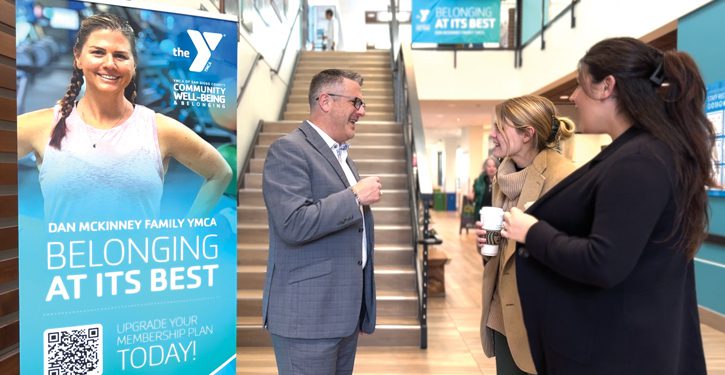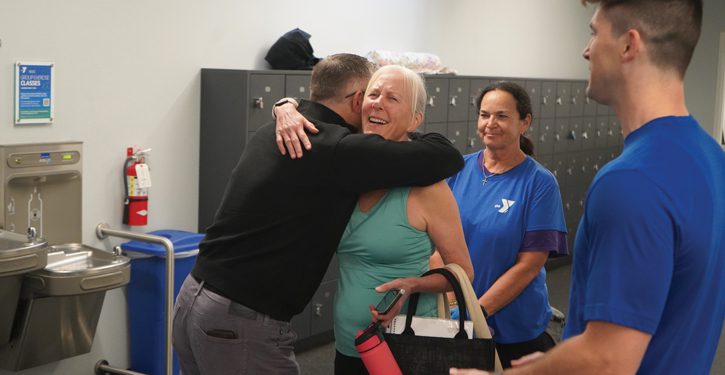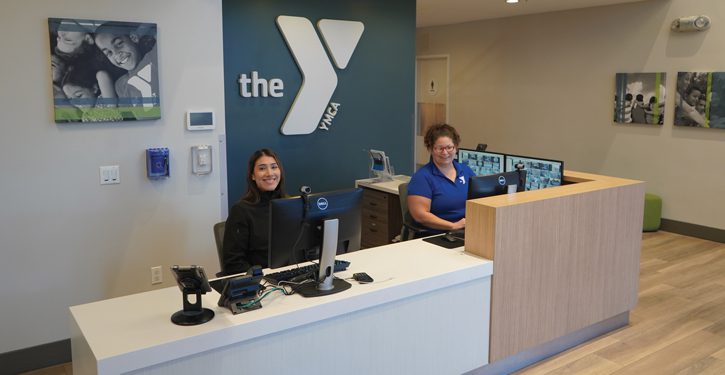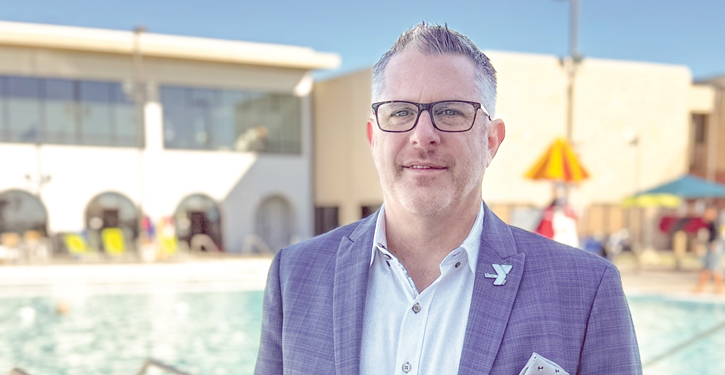Leading with purpose, empathy and unwavering resolve with Todd Tibbits and
the YMCA of San Diego County.
According to the most recent census, California’s San Diego County is the fifth largest in the country. As such, the YMCA of San Diego County is one of the largest Ys in the U.S, serving an estimated 400,000 visitors annually.
The Y’s expansive reach is supported by a dedicated team of almost 5,000 professionals and numerous volunteers, bringing the organization’s mission to life across 14 strategically placed branches, three overnight camps, over 200 childcare locations, three transitional-age housing complexes and countless county-wide social services every day.
Leading an organization of this size is no easy task. However, Todd Tibbits rose to the challenge when he became the CEO and president on August 1, 2021. Upon starting, the YMCA of San Diego County was at a $8 million projected loss in 2021 amid the aftermath of the devastating impact of the COVID-19 pandemic.
Fast forward almost three years later and the Y is now at a projected surplus in the 2024 fiscal year.
“It’s the pinnacle of our success, evidencing our organization’s resilience and impact,” said Tibbits. “This turnabout has permitted us to reinvest and ensure our YMCA thrives post-pandemic. It’s this collective journey to prosperity and the tangible manifestation of our values that I hold in highest regard.”
A Plan Comes Together
Before arriving at the YMCA of San Diego County, Tibbits was the CEO of the YMCA of Greater Charlotte, which he said was nationally recognized as one of the top Ys in the nation. However, he was attracted to the varied approach featured at the San Diego County YMCA for decades.
“Certainly, the Y has a strong presence in the traditional YMCA spaces, but they are really diversified,” said Tibbits. “Especially after coming out of COVID-19, that was really intriguing for me along with what the Y does in the social service space. As we continue to rebuild membership out of COVID-19, social services are about 60% of our revenue. That’s what really makes us a little more unique.”
Despite these initial positives, there was still the $8 million deficit to overcome. Tibbits said the first thing the Y’s leadership team did was recognize and be honest with the challenge at hand. Realistically, this issue would not be fixed overnight. A new, organization-wide commitment was needed.
A strategic plan was created called Drive to Thrive. “We recognized we were not thriving,” said Tibbits. “Our team from an emotional well-being standpoint was very impacted. We knew we couldn’t stay there. We used this metaphor of a road and that we’ve had pitstops along the way. What we committed to was to do better than that initial budget, then cut the deficit in half the next year, then in the third year eliminate it. We were disciplined in that approach.”

Not only has there been a focus to grow back the Y but Tibbits said there’s been a concentration on improving foundational organizational strength.
Laura Merritt, the association senior communications director, said the leadership team ensured these goals were accompanied by intentional outcomes and robust measurement tools to track progress and impact effectively. Also, fostering strong communication channels across the Y was paramount to their success.
“This includes championing two-way communication wherever possible, promoting transparency and encouraging feedback loops that validate the voices of all stakeholders,” said Merritt. “Maintaining an effective leadership team hinges on the implementation of several strategies. Central to these is the articulation of clear goals and objectives that align with the Y’s mission, vision, values and providing a focused direction for all initiatives.”
A Culture for Everyone
While the strategic plan was a huge factor in the YMCA of San Diego County’s comeback, integrating diversity, equity, inclusion and belonging (DEIB) principles and leadership competencies has been a large focus as well.
Merritt said Tibbits’ inspirational and inclusive leadership style has helped power this emphasis. “He acknowledges the unique strengths of each team member, valuing their contributions and ensuring a diversity of perspectives is not just heard but actively sought,” she explained. “This approach cultivates an environment where team members feel valued, connected and confident in the decision-making process.”
Julian Villegas, the vice president of diversity, inclusion and belonging, said during Tibbits’ time as CEO the Y has taken significant strides toward nurturing a culture of supporting DEIB work. Tibbits has been instrumental in driving a vision for the Y to grow toward being a national leader in fostering inclusivity.
“His role as the Chair of the Border Coalition for YMCA of the USA not only amplifies the Y’s outreach, but also cements its role in providing care for migrant youth, marking the Y’s presence on the global stage of social equity,” said Villegas. “Furthermore, Todd has embraced the importance of leadership diversity by enabling staff participation in programs like the Emerging Global Leaders Institute and the Multicultural Executive Leadership Institute. His support has also seen Y leaders bring their voices to national platforms, representing our Asian Pacific and LGBTQ+ communities, and fostering a broader perspective and deeper understanding within our organization.”
One reason why Tibbits is so focused on this issue is because he believes the YMCA is uniquely positioned in communities to create bonds across societal differences.
“Consider the mission of the YMCA,” said Tibbits. “Those words ‘for all’ are in it. So, what does that mean? Boil it down, it’s about health equity and access. Who has access and who truly does belong? The Y has tried to do that across the country. When I see our values manifested, I see us as the unifiers in community. To do that, you must recognize inequities in our communities.”

Aside from the leadership of Tibbits, the Y is backing up DEIB principles through the implementation of inclusive initiatives across all Y locations.
Namely, Villegas said the organization completed 41 diversity, inclusion and belonging tours where they held in-depth discussions with both staff and volunteers, gaining valuable insights into the dynamics of their internal culture.
“These insights are pivotal as they inform the development of strategies that reflect the perspectives of all levels of our team and not simply those from the executive suite,” said Villegas. “Additionally, we’re conducting thorough policy assessments and implementing tools and recommendations that will drive the expansion of committees. This groundwork is crucial as we prepare for the establishment of our DEIB collaborative, further strengthening the ties that bind our diverse community together.”
Shifting to Well-Being and Belonging
At the end of 2023, the YMCA of San Diego County rebranded its strategic priorities around enhancing community well-being and belonging. To define the rebrand, the Y used a framework called The House, with community well-being and belonging being at the top, or the roof, in the outline.
“It’s grounded in our mission, vision and values, which is the foundation,” said Tibbits. “Five key components of our strategic plan make up the rooms. Four are what we do: team well-being, equitable opportunity, organizational strength and organizational relevance — the last two are tied together like yin and yang. The fifth facet is how we execute the plan, which is freedom within the framework.”
That freedom is necessary due to the expansive size of the county. How one branch approaches the plan might be totally different from how another branch implements it.
“Socioeconomics are different in various sections of the county,” said Tibbits. “We expect our executives and local boards to find and have freedom within the framework. Stay within our priorities, but how they’re delivered in our community can be unique. We encourage our local branches and camps to exercise that freedom. This is how we got to where we are now.”

One key concentration within the framework seeing a strong emphasis is childcare access for all. Merritt said the Y is concentrating on supporting youth in all Y programs and services to positively impact their mental, physical and emotional well-being, combating the growing mental health crisis. For example, within the past year the Y provided childcare referrals for 22,474 children, provided respite care to 1,231 families and administered childcare vouchers to support 5,577 families throughout San Diego County, impacting 100,690 individuals through the Y’s Childcare Resource Services.
Another key area is team well-being. For example, Tibbits said his ‘Time with Todd’ grassroots initiative ensures he remains connected with staff at every level by talking with them individually.
“It’s a way for me to intentionally not be in the office and be in the field,” said Tibbits. “The agenda is whatever they want it to be. Largely, it’s just a casual dialogue where I’ll ask questions like, ‘What are you most proud of at your Y? What are the biggest challenges I need to be aware of? How can the association support you?’ I always encourage them to ask me anything. Time with Todd is just a small piece, but we’re trying to be intentional.”
Empathic Leadership
As the YMCA of San Diego County moves into a bright and hopeful 2024, Tibbits said the organization may have a financial surplus, but leadership isn’t using that terminology. Instead, they’re calling it a reinvestment fund.
“As we redevelop these resources, we’re reinvesting in our team and in our infrastructure, which is our facilities and technology,” said Tibbits. “To be impactful, your team is your hands and your feet. They’re critical to delivering the mission and values of your organization. You can have a great strategy, but unless you have a team that will execute, it will fall short.”
Tibbits said he learned this titular lesson when during his time at the Y in Charlotte, the negative impact of the COVID-19 pandemic forced 3,500 team members to be furloughed. Amidst this unfortunate time, one of his co-workers told him, “Don’t ever forget this: Hurt people, hurt people.”
“That stuck with me,” said Tibbits. “That’s why the notion of team well-being is so important. Our team needs to be well for them to fully deliver community well-being. If our team is well, they’re in the right position. Our vision statement as a Y is to be the catalyst to transform lives and communities but we want to first do that with our team. Hurt people may hurt people. But if you love on people, they will love people. We’re far from perfect, but that’s the intent we will have.”










